Helios › Roman Artillery » Origins and History
Articles and Definitions › Contents
- Helios › Who Was
- Roman Artillery › Antique Origins
Ancient civilizations › Historical places, and their characters
Helios › Who Was
Definition and Origins

Helios (also Helius) was the god of the Sun in Greek mythology. He was thought to ride a golden chariot which brought the Sun across the skies each day from the east (Ethiopia) to the west (Hesperides) while at night he did the return journey in leisurely fashion lounging in a golden cup. The god was famously the subject of the Colossus of Rhodes, the giant bronze statue considered one of the Seven Wonders of the Ancient World.
HELIOS IN MYTHOLOGY
In Greek mythology, Helios is the offspring of the titans Hyperion and Theia. His sisters were Selene (the Moon) and Eos (Dawn). Hesiod informs us in his Theogony that with Perseis, daughter of Ocean, he had two children, Circe and king Aietes, who ruled at Kolchis. Later, Apollodorus adds Pasiphae too. Helios is also the father of Phaethon, whose mother was Clymene. When the youngster discovered that his father was the Sun he went to him in the east and asked for a gift. Helios offered him anything he wished, and Phaethon asked if he could ride his father's blazing chariot across the sky. Helios consented, but the favour turned into a tragedy when Phaethon proved unable to control Helios' wild horses, and when he spun out of control, Zeus was obliged to strike down Phaethon with a thunderbolt lest he set the whole world on fire.
Helios pops up in several other Greek myths, albeit in mere cameo appearances. The Sun god shines on the amorous couple Aphrodite and Ares revealing to Hephaistos the illicit shenanigans of his wife in the trap he had set. Helios also appears in the Hercules myth when the hero was performing his 10th labour to fetch the cattle of Geryon from Erytheia in the far west.Fed up with the burning sun on his outward voyage, Hercules threatened to fire one of his arrows at Helios. The god, rather than punish Hercules for his petulance, rewarded his daring by gifting him a golden bowl which he used to sail the seas in greater comfort. The bowl must have been a large one because when the hero gathered together the cattle he herded them into the bowl and brought them back to Mycenae that way. When home safe again, he returned the bowl to Helios with gratitude.
THE FAMOUS BRONZE STATUE OF HELIOS KNOWN AS THE COLOSSUS OF RHODES WAS CONSIDERED ONE OF THE SEVEN WONDERS OF THE ANCIENT WORLD.
The famous sacred cattle of Helios, which he kept on Thrinacia (perhaps Sicily or Malta), were stolen once by the giant Alkyoneus, an outrageous act which was avenged by Hercules. Helios again had some of his flock attacked, and this time eaten too, by the hungry comrades of Odysseus on their long voyage home from the Trojan War. In vengeance, Helios enlisted the help of Zeus who destroyed the ship and drowned Odysseus' crew for their impiety.
CULTS & WORSHIP
The god was not the subject of a wide-spread cult, but Plato informs us in his Symposium and other works that many people, including Socrates, would greet the Sun and offer prayers each day. More direct and ceremonial worship of the Sun was, in fact, held by the Greeks as a point of distinction between other races and themselves, they did not indulge in it while 'barbarians' did. Still, despite being one of the minor gods, the 5th-century BCE philosopher Anaxagoras of Clazomenae did cause outrage when he said that, according to his calculations, the Sun was not a god but a huge burning rock.
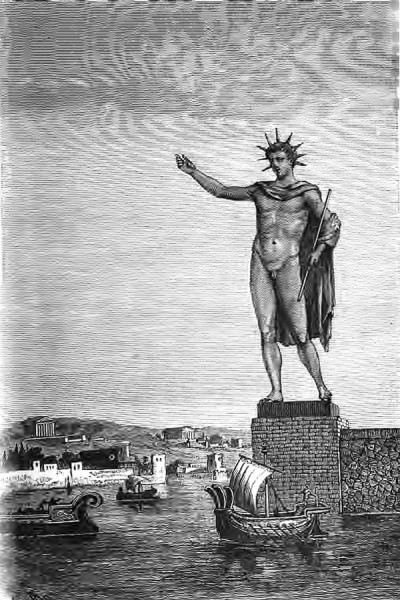
Colossus of Rhodes
The one place in Greece where the worship of Helios was important was on Rhodes. In its founding mythology, the name of the island derives from the nymph Rhodos who bore seven sons to Helios, the patron of the island. Three grandsons of these offspring were the heroes of the three principal cities on the island: Camirus, Ialysus, and Lindus, which were named after them. In honour of Helios, Panhellenic games, the Halieia, were held on the island every five years, and each year a chariot and four horses ( quadriga ) were thrown into the sea as an offering to the god. The famous bronze statue of Helios known as the Colossus of Rhodes was considered one of the Seven Wonders of the Ancient World. At 32 metres high, the massive standing figure of Helios dominated the harbour of the city. Built in c. 304 BCE, it was toppled by an earthquake in either 228 or 226 BCE.
The god Apollo was linked with the Sun from the 5th century BCE, and the association became ever stronger from the Hellenistic period, largely thanks to the influence of Greek philosophers who began to give more importance to celestial bodies. Apollo and Helios then became almost synonymous, just as Hyperion and Helios had been in the Archaic period.The Romans went one step further and made Helios, also known as Sol, an important cult god. Rome ’s Circus Maximus, for example, had a temple dedicated to Sol and Luna (the Moon) from the 3rd century BCE. The worship of Sol gained greater importance in the imperial period, especially during the reigns of the 3rd century CE emperors Elagabalus and Aurelian. The latter was even the son of a priestess of the Sun. A dedicated priesthood, known as the pontifices Solis, managed what was now the most important imperial cult, a position it would hold until replaced by Christianity.
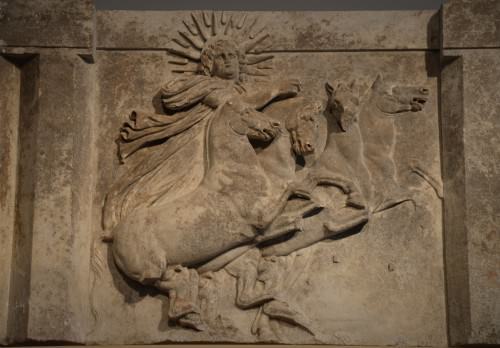
Helios
HELIOS IN ART
Helios appears in all forms of Greek and Roman art, where he is usually depicted as a youth wearing a crown of sun rays.Helios is often in the background or edge of scenes in Greek pottery decoration riding his golden chariot, but in one red-figure kalyx-krater (c. 420 BCE), now in the British Museum, he takes centre stage whilst before him young male children representing the stars descend into the ocean as he approaches. Most often Helios' chariot is pulled by winged horses but sometimes dragons do the job, as in a c. 400 BCE red-figure krater from Lucania which shows his granddaughter Medea at the reigns. Helios also frequently appeared on 6th-century BCE black-figure and 5th-century BCE red-figure pottery in scenes from the Hercules story, again usually riding his golden chariot in the background. The god was, for centuries, also depicted on the coins of his patron city Rhodes.
In sculpture, Helios was shown in the east pediment of the Parthenon where he rises in his chariot from the ocean at the extreme left of the composition. As we have seen his most famous representation in antiquity was as the Colossus of Rhodes, but in Rome similar gigantic statues of the Roman emperors Vespasian and Nero were made to represent these mere mortals as the mighty Helios too.
Roman Artillery › Antique Origins
Ancient Civilizations
Roman artillery weapons were instrumental in the successes of the Roman army over centuries and were especially used in siege warfare, both for offence and defence. Principally used in fixed positions or onboard ships, these machines, known generally as ballistae, could fire bolts or heavy stones over several hundred metres to punch holes in enemy fortifications, batter ships, and cause devastation in the ranks of opposing troops.
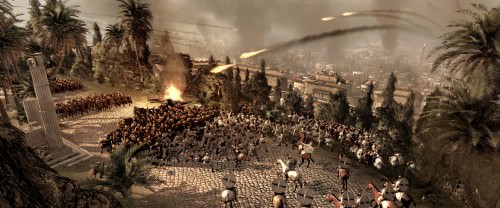
Carthage Under Siege
THE BALLISTA - ORIGINS, DEVELOPMENTS & USE
The Romans continuously improved upon the torsion weapons that had first appeared in 4th century BCE Greece. The two main types were the katapeltēs oxybelēs which fired bolts and the lithobolos which fired stones, both over distances of over 300 metres (as demonstrated in modern full-size reproductions). The Romans evolved these into more efficient machines with greater stability, more mobility, and better materials and design tweaks to achieve ever greater range and accuracy. However, non-torsion catapults were never completely replaced and remained a useful addition to the Romans' formidable array of weaponry.
Artillery weapons which fired bolts or stones (or both) were used to keep defenders off the ramparts whilst rams were used, siege ramps were constructed or towers moved into position to break down the defenders' fortifications. Heavier missiles might also break down defensive walls and allow troops to overrun the city. Ballistae could also be used more imaginatively, for example, placed on the upper floors of siege towers or on the decks of ships. Even so, as these machines were so heavy and their rate of fire relatively slow, they were mainly used as fixed emplacement weapons and not as mobile weapons in field engagements. Arranged in batteries, when possible on high ground, they could, though, provide a devastating volley of fire on enemy positions and must have presented an ominous sight when they were trundled within range of the defenders' positions.
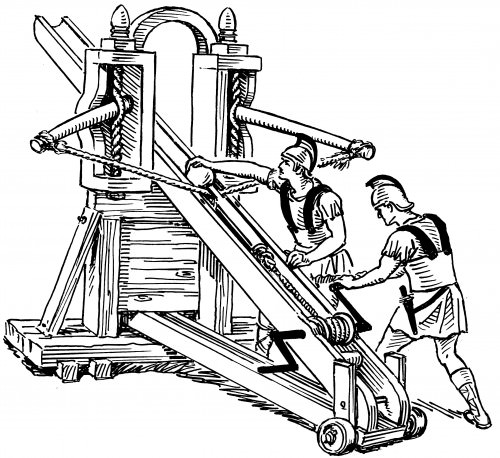
Roman Stone-throwing Ballista
THE CARROBALLISTA, SCORPIO & CHEIROBALLISTRA
Roman torsion catapult ( catapulta ) devices typically looked like a cross-bow in design and had a wooden or, even better, metal frame ( capitulum ) consisting of a stock, winch and base. Two coils of rope ( nervi torti ) made from hair or better, animal sinew and encased in a metal-plated box under tension, acted as springs which, when released, gave the arm ( bracchia ) of the device its power of propulsion. There were many different versions of ballistae and the tension in the rope might also be achieved by turning hand-spikes, windlasses, pulleys or cogs. Technical manuals with calibrating formulae and tables of standard measurements for the various pieces which made up torsion catapults first appeared in c. 270 BCE and indicate that warfare had become a science where technological advancements often brought victory.
As technologies improved, by the beginning of the 2nd century CE artillery did become increasingly mobile, adding a new and lethal dimension to ancient warfare. Trajan 's Column in Rome provides relief sculptures showing cart-mounted carroballistabolt-firing weapons. These were an improvement on older catapults as their spring mechanisms were set wider apart giving the weapon greater firing accuracy. In addition, the all iron frame not only made the whole apparatus lighter and more mobile but allowed the arm to be pulled back even further, giving 25% more power. Vegetius states that each legion was equipped with 55 carroballista and, indeed, every legion had its own dedicated specialists in artillery who not only fired the weapons but also made, repaired and improved them.
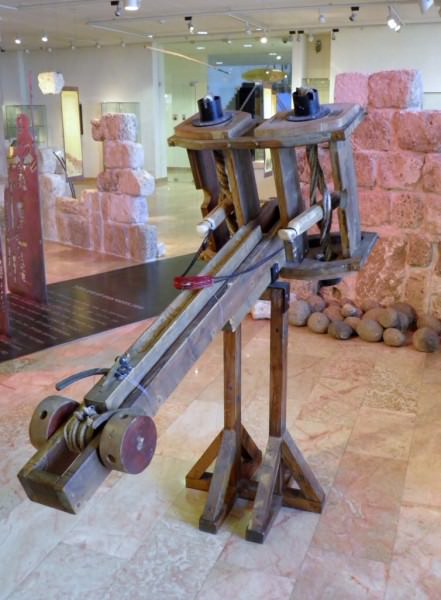
Roman Ballista Reconstruction
The scorpio was a smaller version ballista operated by one man that appeared around the 1st century BCE. (Although confusingly, some later Roman writers would use the term scorpio to refer to large single-armed catapults too). Its smaller size, metal head, and concave arms gave it greater accuracy and power so that in skilled hands it could fire metal bolts with enough force to rip through two enemy soldiers at once. During the 1st century CE another innovation was the cheiroballistra. Also small enough to be operated by a single shooter, the weapon was constructed almost entirely in metal, including the arms, making it more resistant to weather and accurate enough that a sight arch could be added between the two copper -encased springs.
THE 'WILD ASS'
Stone-throwing devices came in various calibres firing stones from as small as 0.5 kg to as large as 25 kg (as used in the 70 CE siege of Jerusalem ). Vitruvius mentions even larger grades of stones, the heaviest being a massive 163 kg. Besides stones there are also records of incendiary missiles being used in Roman warfare, for example, at the siege of Masada in 73-4 CE. The stone-throwers took two forms - either like the arrow-firing apparatus or large one-armed catapults, known in the 4th century CE as the onager or 'Wild Ass' because of its terrific recoil but, in fact, first appearing in the 2nd century CE. Easier to build than the more complex two-armed ballista they were also less accurate and required a crew of eight and a specially built base of brick or earth to achieve some kind of stability when the device was fired and an 80 kg stone launched from its basket.Vegetius claims ten such weapons were assigned to each legion. These more primitive weapons were indicative of the general decline in torsion artillery in the later empire and it would be many centuries until the field of battle once more saw artillery with the sophistication and accuracy that the Romans had been able to field.
LICENSE:
Article based on information obtained from these sources:with permission from the Website Ancient History Encyclopedia
Content is available under License Creative Commons: Attribution-NonCommercial-ShareAlike 3.0 Unported. CC-BY-NC-SA License